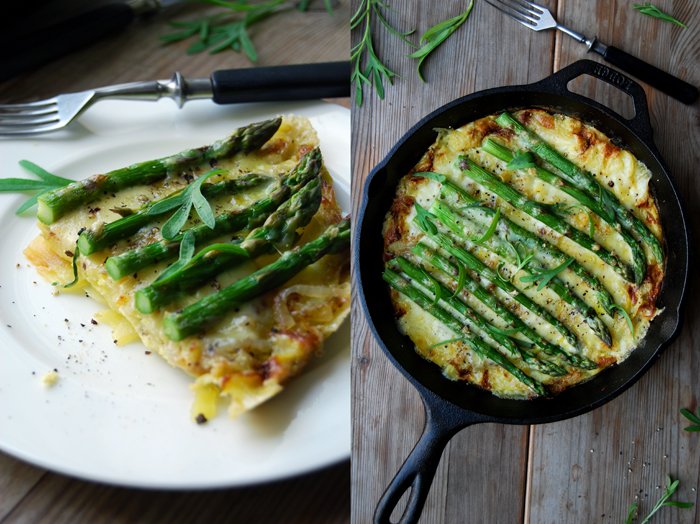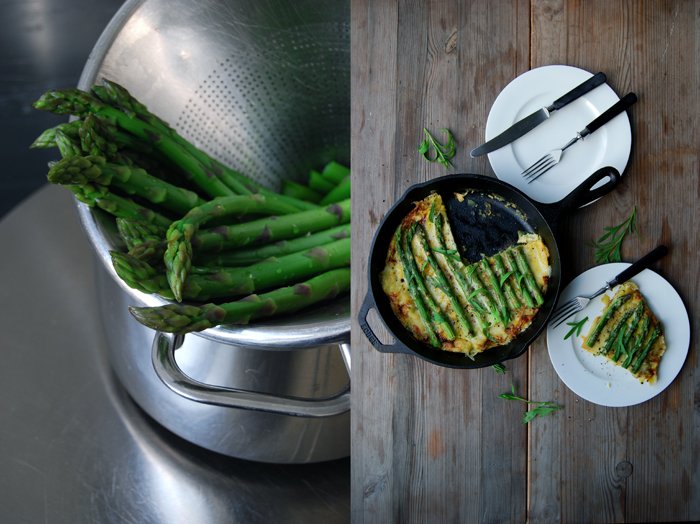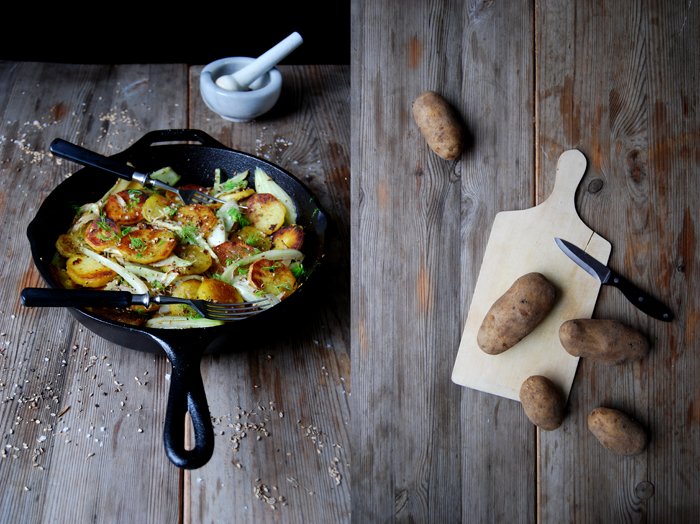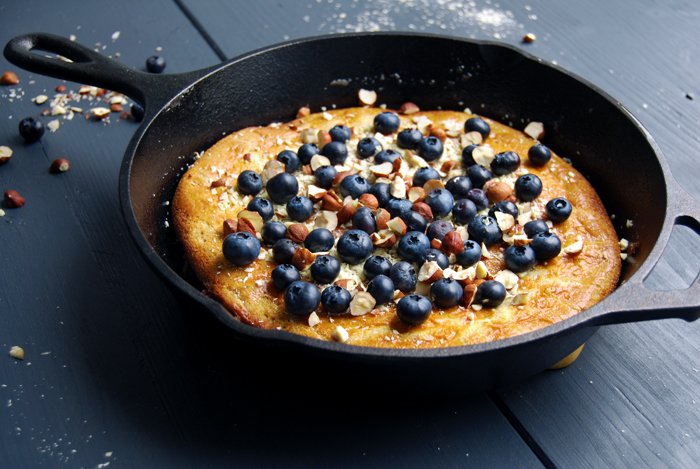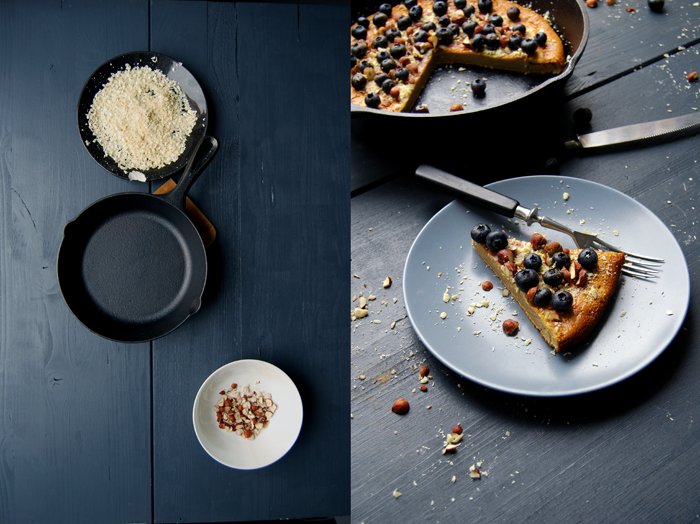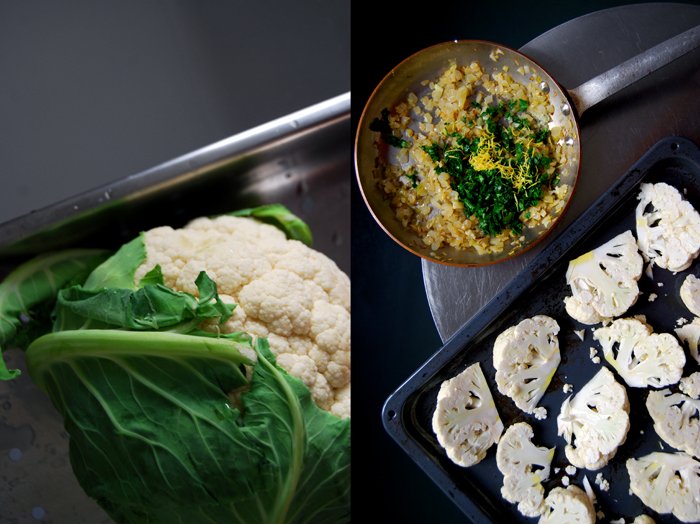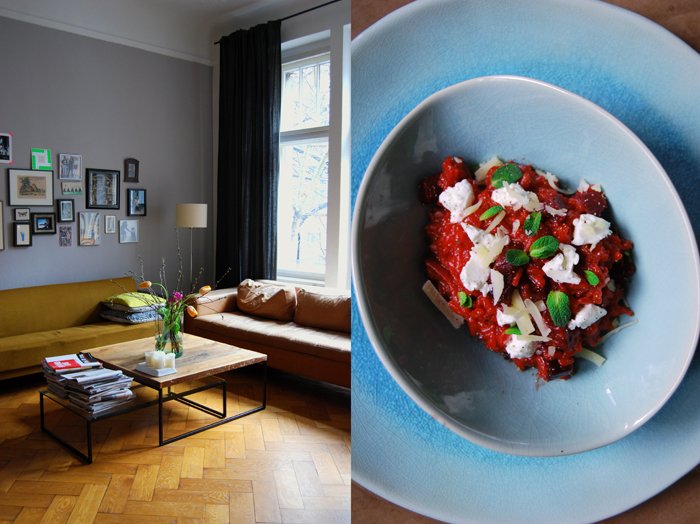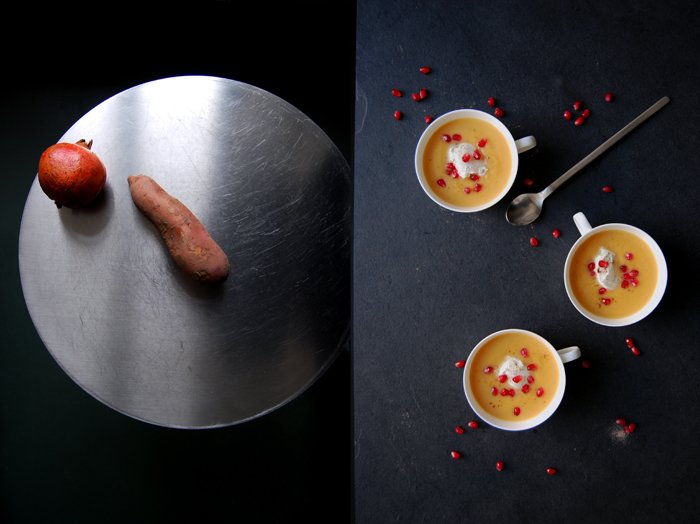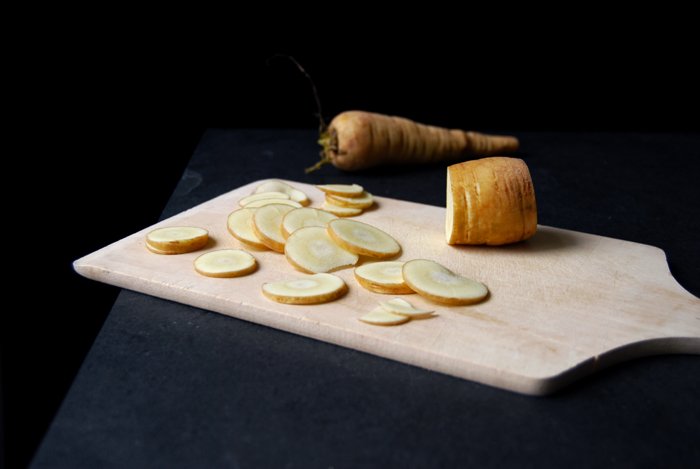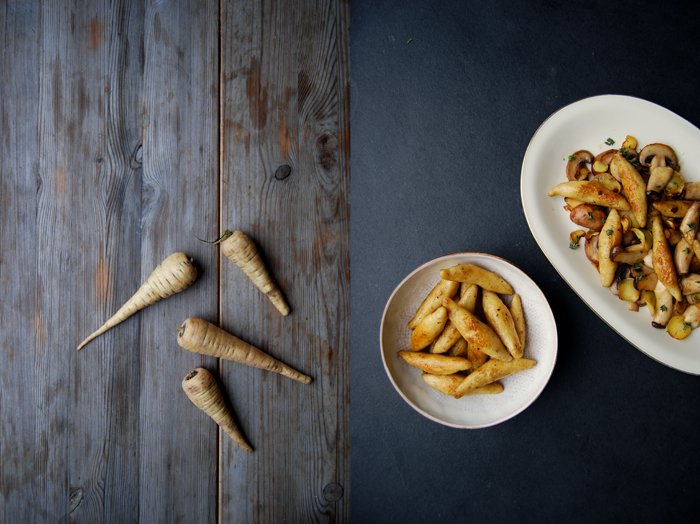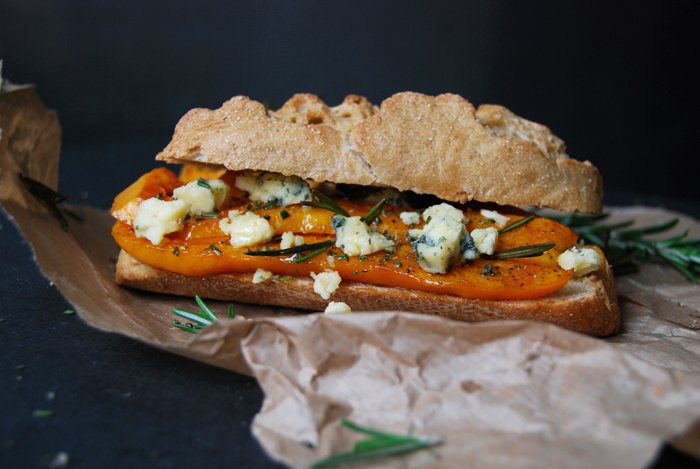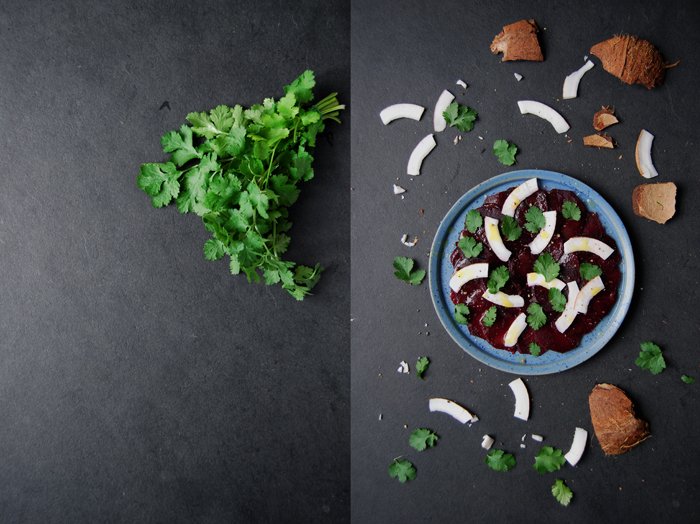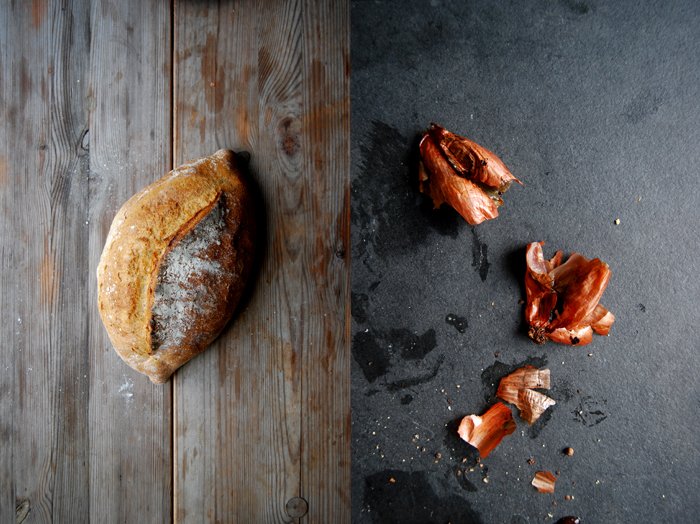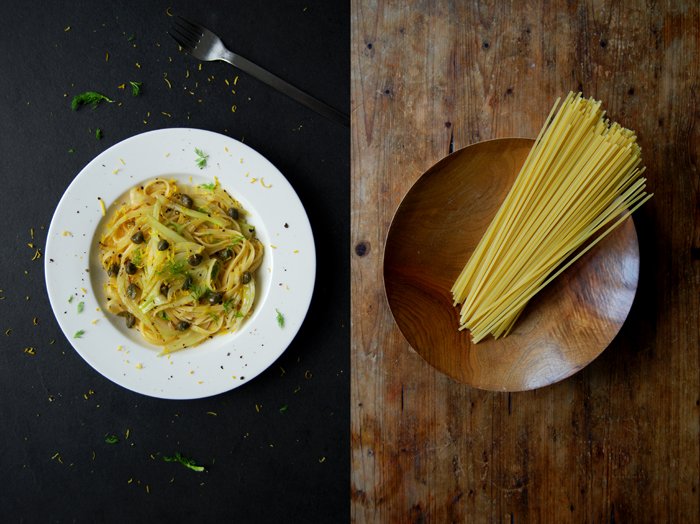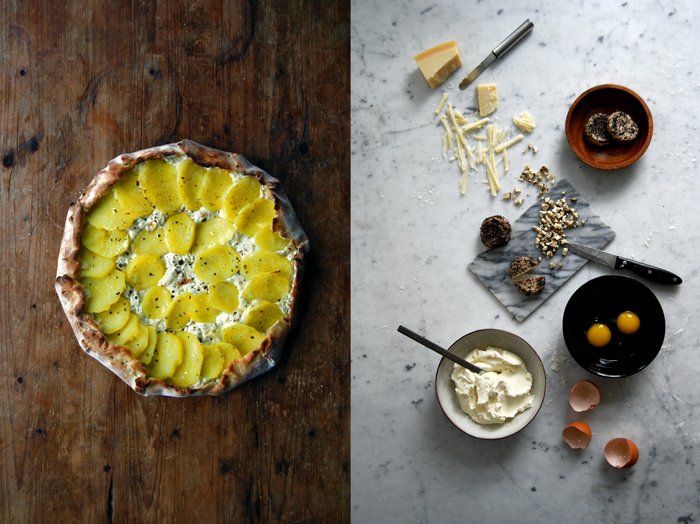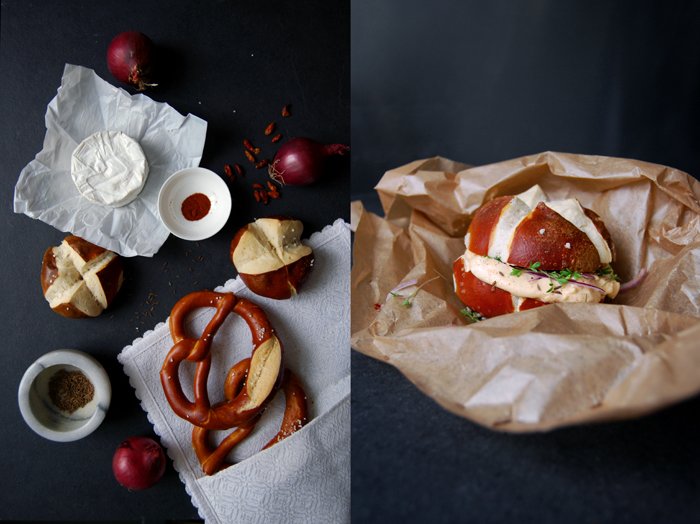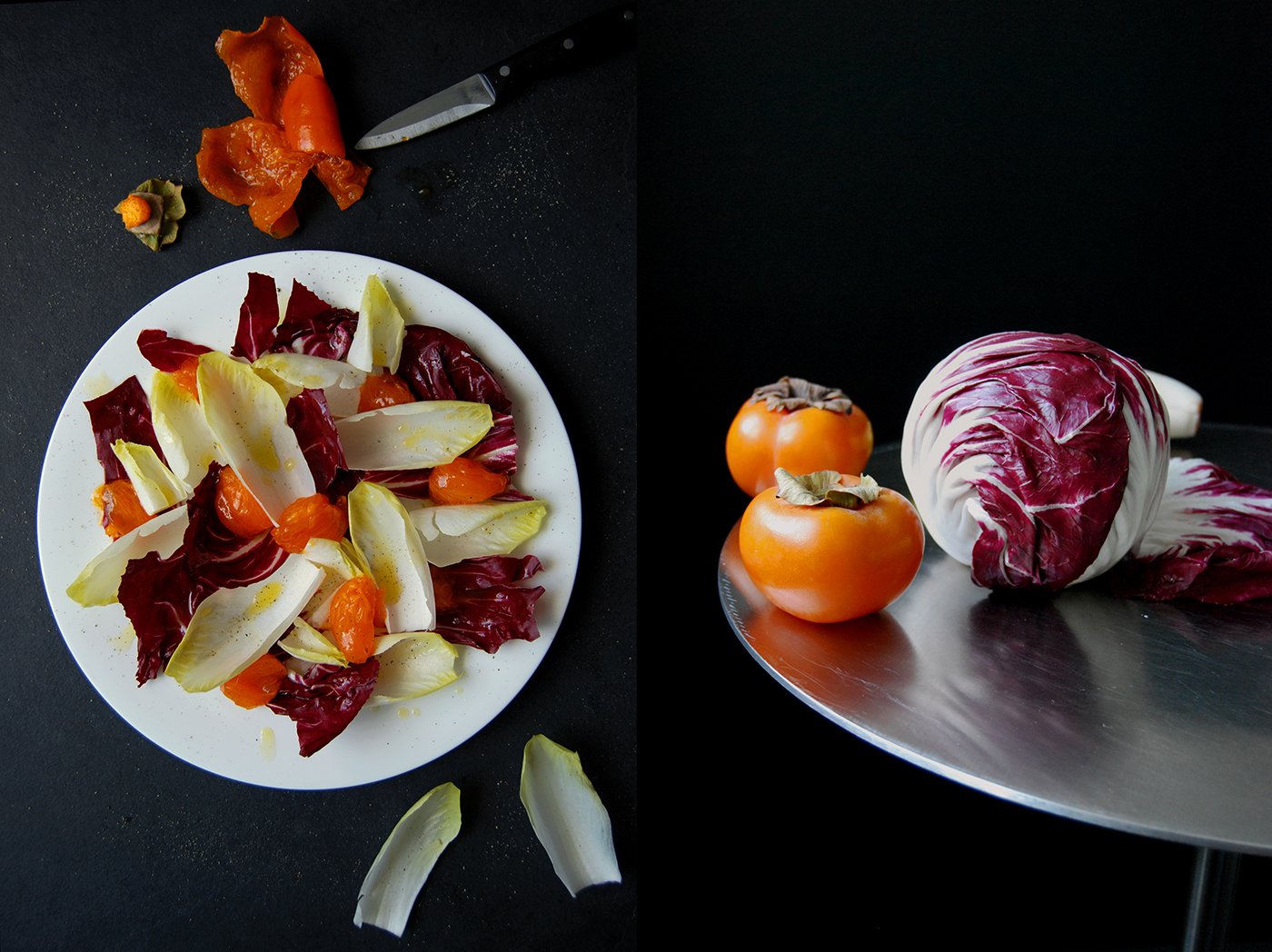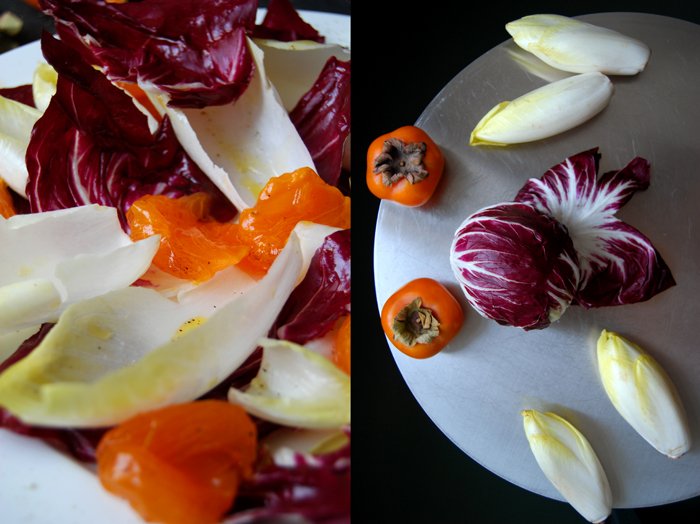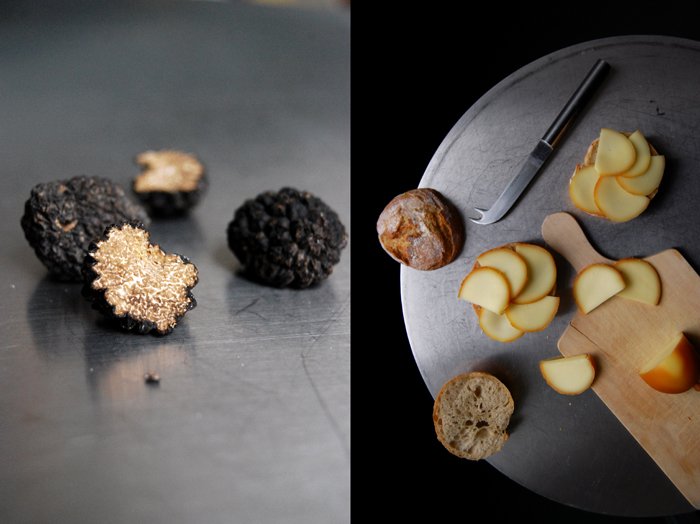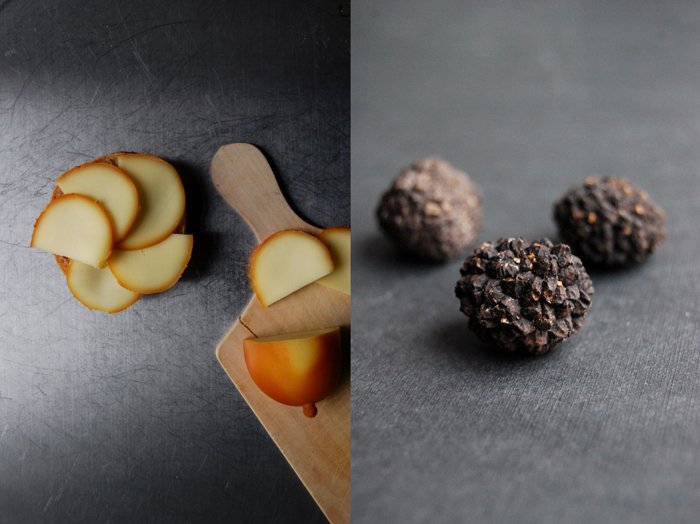Asparagus Tortilla with Mountain Cheese and Tarragon
My first asparagus of the year found its way into my kitchen and I'm as excited as a kid on Easter morning. This is just the start, the beginning of the new season! I can't help thinking of all the other delicious goods which are soon to follow: the first ramp leaves spreading their garlicky aroma in a bowl full of pesto, crunchy fava beans mixed with Parmesan in a creamy risotto, juicy spring cucumber, so concentrated in flavour that some sour cream and dill is enough to throw a quick salad together and enjoy the purest and most simple pleasures of nature's annual awakening. I don't even want to imagine ripe tomatoes dripping juice, I've been missing them for so long and it'll still be a little while before I can savour them. For now I'm just over the moon to have the pretty slim stalks of green asparagus back in my pan.
So two things were on my mind in the past few days which filled me with excitement in the kitchen: the first asparagus of 2015 and my brave decision to make a tortilla after I failed miserably at my first and last attempt more than 20 years ago. My potato omelette was burned on the outside and undone in the middle, a complete kitchen failure created at the beginning of my active culinary journey. Somehow it had an intimidating effect on me considering how long it took to give this dish a second chance. But now I felt ready to give it a go again, my asparagus and some fragrant tarragon at hand to vary this rich Spanish potato classic with some green freshness and a little grated mountain cheese (Swiss Appenzeller) to add its hearty flavours to the vegetables. It's not as big a deal to get the potatoes right as I had imagined (or feared), the only trick is to find the right setting on your cooker. They should cook in the pan on medium heat while covered with a lid without turning black or mushy. It takes about 15 minutes and once they are done, you add some fried onions, eggs and asparagus and let the tortilla cook for a few minutes. I finish it off under the grill to melt the mountain cheese which created a smokey crust on the asparagus. It worked so easily, my tortilla kitchen trauma is finally solved!
Asparagus Tortilla with Mountain Cheese and Tarragon
For 3-4 people you need
green asparagus, trimmed, 400g / 14 ounces
medium waxy potatoes, peeled, 450g / 16 ounces
medium onion, cut in half and thinly sliced, 1
organic eggs 4
hard mountain cheese (like Appenzeller or Gruyère), grated, 60g / 2 ounces
freshly grated nutmeg
salt and pepper
olive oil
fresh tarragon, a small handful, to serve
black peppercorns, crushed in a mortar, to serve
Blanch the asparagus in boiling salted water for 1 1/2 minutes or until just al dente. Rinse with cold water, drain and set aside.
Slice the potatoes very thinly with a cheese or mandoline slicer, spread them between kitchen paper and pat them dry.
In a heavy pan (ovenproof, about 25 cm / 10"), heat a splash of olive oil and cook the onions on medium heat for a few minutes until soft, take them out of the pan and set them aside. Put the pan back on the heat and add a generous splash of olive oil. Spread the potato slices in the pan, close with a lid and cook for about 12 minutes on medium heat. Check the potatoes with a fork after 5-7 minutes by lifting them a little from the side, mind that they don't burn and adjust the temperature if necessary. After 12 minutes, carefully turn the potatoes with a spatula (like a pancake) and spread the onions on top, give them another 2 minutes. Whisk the eggs with 1 teaspoon of salt, pepper and nutmeg and pour over the potatoes, close with a lid and cook for 2 minutes. Arrange the asparagus on top of the eggs, close the lid again and cook for about 4 minutes or until the egg is set. Lay the grated cheese on top of the tortilla and put the pan under the grill for just a few minutes until the cheese starts to bubble. Sprinkle with tarragon and crushed black pepper before serving.
Crispy Pan-Roasted Fennel Potatoes
Fennel seeds are one my favourite spices, preferably the ones I buy from a lovely lady at the market in Marsaxlokk in Malta. Her harvest grows under the hot Mediterranean sun, the plants dig their roots into the limestone soil and clay, in the rich Garrigue. This is the name of a unique and protected ecoregion, scrubland that you find close to the island's coast line, it's rocky and dry and looks a bit like a moon landscape. The ground seems poor but it's actually quite rich in minerals washed out from the rocks, they nurture wild thyme and fennel and add a strong aroma to the vegetation. A single fennel seed is enough to smell and taste the difference compared to the products you can buy in most shops.
My Maltese fennel seeds and the plant's bulb (not from Malta but organic) are the fragrant secrets of my rustic pan filled with golden crisp potatoes. The seeds' and vegetable's sweetness fits perfectly to the yellow roots, together they create an aromatic variation on a comfy kitchen classic. I roasted my potato slices a few hours after they cooked, you have to give them some time to dry out a little if you're after a crisp result. They should always spread evenly in the (heavy) pan and not on top of each other while they are cooking. You might have to roast them in batches but the effort is worth it. I cut the fennel bulb in very thin slices, like a carpaccio, and sautéed them for only 2 minutes in fennel seed infused olive oil. They were just al dente when I mixed them in the pan with the roasted potatoes, crunchy fennel seeds, sea salt and coarsely crushed pepper. We picked up our forks and ate straight out of the skillet, a rather rustic style of eating that fit perfectly to the dish.
Crispy Pan-Roasted Fennel Potatoes
For 2-3 people you need
waxy potatoes, peeled, boiled and rinsed, 700g / 1 1/2 pounds
small fennel bulb, very thinly sliced, the green chopped, for the topping, 1
quality fennel seeds (preferably organic), 1 1/2 tablespoons
olive oil
sea salt
black peppercorns, crushed in a mortar
Let the potatoes cool and dry on a wire rack for at least 1 hour or a day and cut them into thick slices. In a large heavy pan, heat a generous splash of olive oil and fry the potatoes on medium-high for a few minutes on each side until golden brown. Cook them in batches and turn them one by one with a fork to keep their shape. Season with salt and pepper.
Heat a splash of olive oil in another pan and cook the fennel seeds on medium heat for 1 minute (they shouldn't get dark). Pull the pan off the heat, take just the seeds out with a tablespoon and set them aside. Put the pan back on and add the fennel slices, sauté them on medium for about 1 minute on each side without getting dark, they should be al dente. Gently mix the roasted potatoes, fennel seeds and slices in the pan and season with salt and pepper to taste, serve immediately.
Buckwheat Dutch Baby with White Chocolate, Blueberries and Hazelnuts
I ate my first Dutch Baby in Marta Greber's kitchen, the cook and baker behind the beautiful blog What Should I Eat For Breakfast Today?. We met last October for one of my meet in your kitchen features, I was curious about this woman who is known to be so passionate about the first meal of the day. When Marta told me that she'd like to make a Dutch Baby for me I had to ask her for further information, unfortunately I had no idea what to expect on my plate.
To clear the picture for everyone else who feels as clueless as I did then: a Dutch Baby is a pancake baked in the oven in a heavy cast iron skillet. It rises a bit like a soufflé with a buttery crust on the outside. It's a very simple yet very delicious way to start the day! Marta mastered this dish to perfection, you can find her recipe here in the kitchen feature with her. I didn't want to change her basic formula too much. There are variations on this dish with a thiner result but I particularly liked the richness she created. Her recipe uses more flour than the ones that end up with a paper thin bottom, her Dutch Baby is a proper breakfast and not an airy dessert. I wanted to keep that but there is always room to evolve a recipe, to change it in order to give it a new direction. My new direction is called buckwheat!
Inspired by my hazelnut cake made with this tasty flour which found its way onto the blog only a few weeks before I met Marta, I have been wanting to combine these two creations for months: a hearty buckwheat Dutch Baby refined with cinnamon to underline its nutty flavour. The right cast iron skillet was missing in my kitchen which isn't obligatory for this recipe but I've been longing for this heavy pan from Tennessee for years and I didn't want to start this project without this exact kitchen tool (I know, I sound a bit like a child). Thanks to our family, to lovely Ana and Chris in Florida, my cooking equipment has a few new additions: not only one skillet but three plus a casserole dish, it felt like Christmas when the box arrived. My first Dutch Baby is dedicated to these two wonderful people on the other side of the Atlantic, thank you so much for this kitchen gift!
When I finally got started, it took three attempts to learn that you can't expect the same results from buckwheat batter compared to the ones made with lighter wheat or white spelt, it's just not as airy. Buckwheat is simply too heavy to let the pancake rise and bubble like a perfect soufflé, as long as you're not after after a crêpe-thin Dutch Baby which I wasn't. I wanted Marta's thick German pancake texture combined with the buckwheat's distinct taste. So, using only buckwheat was out of the question, it's impossible. For my first batch I used more or less Marta's recipe replacing half the flour with buckwheat. It created a pancake with a certain density that I wanted to lighten up a little. The second batch made with 1/3 less buckwheat flour tasted perfect but I still wanted a different texture and look. The third and final recipe is made with an additional egg and the same amount of the two different flours, and this time I was finally happy. Don't expect a feather-light soufflé but a cosy, nutty, cinnamony warm breakfast treat, slightly cakey, with sweet and creamy white chocolate melted on top. The addition of chopped hazelnuts and fresh blueberries made this comforting morning treat complete!
So where does the name come from? It's another one of these sweet fairy tales. The dish is derived from the German pancake, the word Dutch is a corruption of the word Deutsch, meaning German. A restaurant owner called Victor Manca is supposed to be the person who made the first Dutch Baby in the early 1900 in Seattle, Washington. At least he owned the trade mark. Legend has it that one of his daughters chose the name, referring to the German-American immigrants, the Pennsylvania-Dutch.
Buckwheat Dutch Baby with White Chocolate, Blueberries and Hazelnuts
For a 25cm / 10" cast iron skillet or heavy baking dish you need
butter 80g / 2 3/4 ounces, to bake the pancake
plain flour 60g / 2 ounces
buckwheat flour 60g / 2 ounces
granulated sugar 2 tablespoons
salt 1/2 teaspoon
ground cinnamon 1 teaspoon
organic eggs 3
milk 125ml / 4 1/2 ounces
quality white chocolate, grated, 60g / 2 ounces, for the topping
blueberries 125g / 4 1/2 ounces, for the topping
hazelnuts, chopped, 20g / 3/4 ounce, for the topping
Set the oven to 230°C / 450°F (top/ bottom heat).
Place the skillet or baking dish with the butter in the oven. Let the butter melt and sizzle slightly (it should be hot but not brown). Combine the flour, buckwheat, sugar, salt and cinnamon in a bowl, add the milk and eggs and whisk for about a minute until combined. When the butter is melted, gently pour the dough into the middle of the pan and bake in the oven for about 10-12 minutes or until golden.
When the Dutch Baby is done, take the pan out of the oven and carefully pour out the excess butter. Sprinkle the surface with the chocolate immediately. Lay the blueberries and hazelnuts on top and enjoy warm!
Green Bean, Artichoke and Grapefruit Salad with Kalamata Olives & Rosemary
The change of season is nearing (finally!) and the first spring vegetables are back in my kitchen, green beans! They aren't locally grown and had to travel a bit to reach my cooker but their crunchy green gave me culinary proof that the end of winter is near!
The recipe is easy, I went for a quick bean salad with bittersweet pink grapefruit and a light rosemary orange dressing. I had a colourful plate in mind with lots of different flavours, antipasta feeling combined with sharp freshness. I pulled out a few pantry treasures to mix with the fruit and vegetable: preserved artichoke hearts and juicy Kalamata olives. A strong composition without a single overpowering ingredient, the perfect salad to get prepared for all the summery, culinary pleasures ahead of us!
Green Bean, Artichoke and Pink Grapefruit Salad with Kalamata Olives and Rosemary
For 2 people you need
green beans, the ends cut off, 300g / 10.5 ounces
pink grapefruit, cut into fillets, 1
preserved artichoke hearts, quartered, 4
Kalamata olives 8
olive oil 3 tablespoons
freshly squeezed orange juice 3 tablespoons
fresh rosemary, finely chopped, 1 heaping teaspoon
salt and pepper
Blanch the beans in lots of salted water for 4-5 minutes or until al dente, rinse with cold water for 2 seconds and drain.
Arrange the beans, grapefruit, artichoke and olives in a large bowl. Whisk the olive oil, orange juice, rosemary, salt and pepper and season to taste. Sprinkle the salad with the dressing and serve immediately.
Oven Roasted Cauliflower Wedges with Parmesan, Parsley and Onions
Oven roasting creates certain flavours and aromas in vegetables that you'd never achieve with other cooking techniques like blanching or sautéing. Sometimes it just adds a little finesse to the root, cabbage or squash's own qualities, but in some cases it puts the whole experience on another level. Aubergines are a great example. To me, they show their most delicious side when brushed with olive oil, sprinkled with sea salt and crushed black pepper before they reveal their whole impact under the grill. The exceptional taste of a slice of perfectly grilled aubergine is the best that can happen to this fruit, in my eyes!
A few days ago, I wrote about my low enthusiasm for cabbage this winter, I'm just not in the mood, but still, I had to buy this little head of cauliflower cuteness when I saw it at the market. Sometimes you just need to the see and smell the food on your plate to wake up the taste buds. Oven roasting came to mind and seemed like the right approach to deal with this pretty vegetable. I remembered my baked fennel with homemade sausage I wrote about a year ago, I topped the blanched bulbs with a crust of fried onions, garlic, parsley and parmesan and roasted them under the oven. I prepared my cauliflower the same way, added some lemon zest but left out the pre-blanching. Cut into slim wedges, they only needed 15 minutes to turn into crunchy bites, al dente and with the wonderful aroma of all the roasted flavours.
Oven Roasted Cauliflower Wedges with Parmesan, Parsley and Onions
For 2-3 as a main or 4 as a side dish you need
small cauliflower, cut into slim wedges, 1
medium onions, finely chopped, 2
garlic, crushed, 2 big cloves
fresh parsley, chopped, 3 heaping tablespoons
lemon zest 1 teaspoon
Parmesan, freshly grated (coarse, not fine), 80g / 3 ounces
olive oil 4 tablespoons plus more for frying
coarse sea salt
black peppercorns, crushed in a mortar, to taste
Set the oven to 220°C / 430°F (I used the Rotitherm setting).
Heat a splash of olive oil in a pan and cook the onions for a few minutes until golden and soft. Add the garlic and cook for another minute, stir in the lemon zest and parsley and set aside.
Spread the cauliflower wedges on a baking sheet and coat them with 4 tablespoons of olive oil. Sprinkle with sea salt and pepper and roast in the oven for 10 minutes. Turn the wedges and roast for another 5 minutes. Cover the cauliflower with the onion parsley mixture and sprinkle with Parmesan. Bake for 4-5 minutes or until golden brown.
Rosemary Butter Beans with Maple Roast Roots
I don't know why but this winter I didn't really get into the mood for cabbage. Give me beans, lentils, all kinds of legumes and I'm happy. And whenever I pulled roasted roots out of my oven I was almost ecstatic, but cabbage, unfortunately, left me a bit uninspired. This is quite unusual for me, I would sometimes cook it every week in big batches in the cold season, cauliflower, kale, red cabbage heads and savoy, my freezer was always full with leftovers from my various cabbage creations.
I believe that you should follow your taste, your gut feeling in life. Whatever your appetite calls for stands for something that your body needs at that moment, not only when it comes to food. Lets leave out the excessive consuming of chocolate and cakes, this doesn't count in my train of thought, that's more for the soul rather than for the body, which is as important. My appetite definitely calls for legumes and roots! There weren't many cabbage recipes on eat in my kitchen this winter, just three, my Ginger Lemon Ricotta stuffed Cabbage Rolls, Savoy Cabbage with Coriander and Maltese Sausage and the Christmassy Roasted Red Cabbage with Orange Wedges. Roots, beans and lentils, that's what I put into my pots and pans most of the time.
Today's recipe combines both, velvety butter beans cooked with rosemary and caramelized mixed roots roasted in the oven in sticky maple syrup olive oil. The carrots, beetroot and Navet roots (yellow turnip) were still a bit crunchy and just as good when they were cold. This was our energising snack together with yesterday's olive oil bundt cake while we remodeled the kitchen. This dish works as a warming meal or a rich salad, just prepare a bigger batch and enjoy it for days!
White Rosemary Beans and Maple Roast Roots
For 3-4 people you need
dried butter beans, soaked in lots of water overnight, 250g / 9 ounces
broth to cook the beans (or 1 carrot, 1/4 celery root and 1/4 leek)
fresh rosemary, a small bunch
Navet roots (yellow turnip), cut into wedges, 3 (or 1 small rutabaga, peeled)
medium beets, peeled and cut into wedges, 2
carrots, peeled, cut in half (lengthwise), 10
cloves of garlic, in their skin, 6
olive oil 6 tablespoons
maple syrup 1 tablespoon
balsamic vinegar 1 teaspoon
coarse sea salt and pepper
In a large pot, cook the beans in enough broth - or in water with the carrot (cut in half), celery (peeled) and leek (cut in half) - for about an hour, don't add any salt. Add a sprig of rosemary in the last 15 minutes. When the beans are done take them out with a slotted ladle and mix them with 1 tablespoon of olive oil, balsamic vinegar, salt and pepper. Season to taste.
Set the oven to 200°C / 390°F (I used the Rotitherm setting).
Whisk 5 tablespoons of olive oil with the maple syrup and pepper. Spread the Navet roots, beets, carrots and garlic in a large baking dish or on a tray and coat them with the maple oil, add a few sprigs of rosemary. Sprinkle the roots generously with coarse sea salt and roast in the oven for about 45 minutes or until golden brown and al dente, turning them every 15 minutes. Serve on top of the beans.
Oven Roast Pumpkin with Pistachio Cumin Feta
Oven roasted pumpkin has always been on the top of my list of winter favourites but I recently found out about a combination which makes this dish even more tempting: pumpkin, pistachios and feta cheese!
The woman who introduced my taste buds to these culinary highs wrote a wonderful cook book called Persiana which I happily found under our Christmas tree. Sabrina Ghayour managed to come up with an amazing collection of beautiful recipes from the Middle East and beyond that caught my attention from the first page. Her family's Iranian background combined with the fact that she grew up in England, let the self-taught chef create magical and manageable recipes praising her big culinary love, the Persian cuisine, by using ingredients that can easily be found at every supermarket. I find great relaxation and inspiration in this little gem, in the way she talks about food in general and about single aromas in particular.
Although I didn't have the time to cook many of her creations yet, I already read through the book three or four times. Her butternut squash with pistachio pesto, feta and pomegranate struck me every time I passed the page.
I rarely follow cook books to the letter, I love to work with them and develop my own ideas, that's what happened with Sabrina's butternut dish. I roasted Hokkaido wedges the way I always do and added a little cumin to the olive oil which is very nice with the squash's sweetness. Her pesto didn't make it into our dinner, but I whipped salty feta cheese with lots of pistachios, olive oil and cumin to a thick dip that I served on top of the warm squash. The combination of nutty, sweet and salty aromas is simply brilliant!
Oven Roast Pumpkin with Pistachio Feta Cheese
For 4 people you need
Hokkaido pumpkin or butternut squash, cut in half, the seeds and fibre scraped out, 1kg / 2 1/4 pounds
feta cheese 180g / 6 1/2 ounces
pistachios (in their shells) 200g / 7 ounces
olive oil 50ml / 1 3/4 ounces plus 3 tablespoons for the feta
ground cumin
coarse sea salt and pepper
Set the oven to 200°C / 390°F.
Cut the pumpkin into large wedges, don't peel it. Whisk 50ml (1 3/4 ounces) of olive oil with pepper and 1 teaspoon of cumin. Spread the pumpkin in a baking dish and coat with the spice oil. Sprinkle the wedges with salt and bake in the oven for 15 minutes. Turn the wedges and cook for another 7 minutes (Hokkaido) or 15 minutes (butternut) or until golden brown and soft.
Grind 60g / 2 ounces of the peeled pistachios in a food processor and purée with the feta cheese, 3 tablespoons of olive oil and 1/4 teaspoon of cumin until smooth and well combined. Season to taste.
Arrange the warm pumpkin and the pistachio feta on plates. Peel and chop the remaining pistachios and sprinkle them over the cheese. If you like, add a little more cumin (to taste).I
f you choose Hokkaido, you can eat the skin, but if you went for butternut squash, you have to scrape it out of the skin (you can do that on your plate).
meet in your kitchen | Isa's Beetroot Risotto with Chèvre and Mint
On to part II of Berlin's Hauptstadtmutti cooking session! The popular mother, fashion and lifestyle blog is run by Isa and Claudia, both such vibrant and inspiring ladies that I had to visit both of their culinary spaces. Two weeks ago, I learned how to make Claudia's Ukrainian Pelmeni dumplings (you can read about it here) and now it's time to cook in Isa's kitchen.
It was cold and snowy as I made my way to meet Isa, the city was wrapped in a wintery grey and, although it was already 10 in the morning, it was quite dark when I reached the old house where the young mother lives with her little family of four. The imposing building is one of the few on the street which hasn't been renovated, the facade crumbling between the majestic window frames which gives it quite a morbid charm, you can still see the beauty of the past. It looks a bit like an abandoned house in a fairy tale, it's more than impressive and it sparked my fantasy when I walked up the creaking steps to knock on Isa's wooden door. But then, when I entered her home, I was speechless, endless rooms and corridors, herringbone parquet floors, high ceilings lined with decorative stucco and large windows which let in the most dreamy light. Within seconds I fell in love with this elegant but cosy home!
Isa started Hauptstadtmutti in 2011 together with Claudia. In the first part of our cooking series I talked about their fascinating and complementary personalities which led to the two meet in your kitchen features. Both women share an international upbringing which confronted them with various cultures at a young age. Claudia grew up with an Eastern European background and Isa had quite an adventurous childhood, she lived in Baghdad in Iraq during the first 4 years of her life. Her father was a successful engineer who used to live in East Germany with his wife before his skills took him and his young family to the Middle East to design pump stations. Back in East Germany, he was also involved in the construction of the GDR's first nuclear power station. Despite this experience, or perhaps because of it, the whole family turned to a more alternative lifestyle in the following years. They became politically active, focussed on natural home grown food and raised awareness for healthy living.
As a teenager, Isa joined yoga and meditation classes together with her father and mother. Today, her parents practice Tai Chi together with their friends in the family's grand garden which is part of an old farm established by Isa's grandfather. The family takes their well-being into their own hands, one generation after the other, and the next one is waiting in line. Isa passes her experiences on to her children and although they are still quite young they can already enjoy her delicious food. Isa's cooking truly pleases the taste buds, she creates culinary moments of bliss without regrets, her food is healthy, with organic ingredients, and full of flavour. She made a fantastic beetroot risotto for me, it was cooked to perfection, the rice corns and roots were al dente, just how I like it. She refined her composition with chèvre, parmesan and fresh mint - a great composition I can only recommend!
Beetroot Risotto with Chèvre and Mint
For 2-3 people you need
small beetroot 2
risotto rice (Arborio) 250g / 9 ounces
onions 2
clove of garlic 1
honey 1 tablespoon
a shot of white wine
vegetable broth 1/2-1 l / 1-2 pints
freshly grated Parmesan, a handful
butter 1 tablespoon
olive oil
salt and pepper
mint 4 small branches
fresh goat cheese (chèvre), for the topping
Peel the beetroot, garlic and onions and cut them into cubes. The larger the beetroot cubes, the more bite they'll have. Warm up the broth in a saucepan, it should be simmering.
In a large pan, heat some olive oil and cook the onions and garlic until glassy and soft. Add the beetroot and honey to the onion and let it caramelise slightly, add the rice and let it cook for a minute. Deglaze with a splash of white wine and add a ladle of broth. When the liquid has been absorbed add more broth, a little at a time stirring in between. When the rice is al dente, take the pan off the heat. Stir in the butter and Parmesan cheese and let them melt into the rice. Season with salt and pepper to taste and sprinkle with chèvre and mint to serve.
You spent the first three years of your life in Iraq due to your father's work as an engineer before your family moved back to East Germany. How did this experience influence your family and how did it effect your own personality?
Concerning that I should probably explain that my parents were neither in the communist party nor in the homeland security of former East Germany so it was quite a mission for them to get to live and work outside the country. But they made it because of their skills and raised my brother and I to believe that "You can get everywhere if you really want it". That really brought me to a lot of places and made me later want to live in other countries as well. We also have a very open minded attitude towards other cultures in our family.
Do you think traveling is important for children to get to know different cultures and mentalities? Can you give some tips for traveling with young children?
If they are very young I don't know. They will not really remember it. We did not travel too far away with our kids yet. Switzerland, France, Denmark. It is not that stressful for them but sometimes for us, the parents. Sometimes it is more fun to spend a week at the Baltic Sea than to travel for hours and hours. It is always good to have plenty of books with you, especially Wimmelbücher (picture books).
Your parents encouraged a great awareness for natural food and a healthy lifestyle by their own way of living. How did they influence your consumption, your cooking and the food you buy?
Oh yes, my mother was very into healthy food when we were young and still is. She cooks her own jams from the fruits of her garden and we always ate fruits and vegetables from the garden. She always uses fresh and natural ingredients. The older I get, and of course with children, I try to live as healthy as I can too. I usually buy local or organic fruits and vegetables.
You went to high school in the US for one year, what fascinated you about this new culture? What are your culinary memories?
Everybody was very very friendly and I just had a very great teenage time there. Culinary memories? Donuts, cheeseburger, tacos and ice cream (smiling)!
As an au pair in Paris, you also experienced the French cuisine for one year. What did you like about the food there?
It is very pure, many vegetables and beef and lots of seafood. I liked that very much and the oysters. I learned how to eat oysters. Delicious!
Did your cooking change since you became a mother? Do you have any tips to make cooking for and eating with young children easier?
I really changed into organic and local food. Eating with young children is easy. I always cooked the baby food by myself. This is totally easy and does not take a long time. What I learned is that young children want a variety and a change of food every day. They do not like to eat the same thing every day over and over. My tip is to always try to eat the same as your kids. They copy you and will (often) try more.
What was the first dish you cooked on your own, what is your first cooking memory?
The first dish was Spaghetti Bolognese. I learned this when I was 12 when my mother was away for an allergy cure and our father taught it to my brother and I.
As a fashion observer and blogger, which are your 3 most helpful fashion tips for young mothers?
1. Always carry a large scarf for nursing in public.
2. Get a new haircut. It makes you feel good.
3. Buy at least 3 shirts or dresses which make nursing comfortable.
Where do you find creative inspiration?
In Berlin, walking around the city and on the internet reading international blogs and magazines.
What are your favourite places to buy and enjoy food in Berlin?
I love to eat at Cordobar. Great food and the largest selection of wine. And I like to buy food at Mitte Meer.
What did you choose to share on eat in my kitchen?
Beetroot risotto.
If you could choose one person to cook a meal for you, who and what would it be?
Janine (a friend), roasted root vegetables.
You're going to have ten friends over for a spontaneous dinner, what will be on the table?
Risotto!
What was your childhood's culinary favourite and what is it now?
Spaghetti Bolognese and now it is fish, especially Sushi.
Do you prefer to cook on your own or together with others?
Together with others.
Which meals do you prefer, improvised or planned?
Planned.
Which meal would you never cook again?
Octopus.
Thank you Isa!
Parsnip & Sweet Potato Soup with Pomegranate & Mascarpone
Roots and fruits are a great match for puréed soups, they merge to a deliciously warming treat full of fragrant flavours. They often balance each other out, like the strong parsnip which has such an overpowering impact that it's best in combination with other ingredients that underline its subtle sweetness.
I went for robust sweet potatoes, a great team player, and juicy pomegranate seeds, their sourness is a wonderful addition to the earthy aroma. And, of course, their dramatic look is quite a stunner on the root's pale pink! When I cook these kind of soups I like to spare on heavy cream, I just stir in a little bit to support the natural creaminess which is already given through the puréed vegetables. It doesn't need much of the dairy product otherwise it will turn into a heavy meal and that's the opposite of what I'm after. I prefer to refine the roots with another kind of milkiness, a discovery I made in October for my parsnip and pear soup. I used whipped mascarpone cheese, just a small spoonful, but this time I mixed it with cardamom and a bit of orange juice, it literally melted into the root composition!
Parsnip & Sweet Potato Soup with Pomegranate & Cardamom Mascarpone
For 4 as a starter you need
parsnip, peeled and chopped, 300g / 10.5 ounces
sweet potato, peeled and chopped, 200g/ 7 ounces
medium onion, chopped, 1
vegetable broth 800ml / 2 pints
bay leaf 1
rosemary 1-2 small sprigs
olive oil
heavy cream 75ml / 2.5 ounces
salt and pepper
honey 1-2 teaspoons, to taste
ground cardamom
mascarpone 100g / 3.5 ounces, for the topping
freshly squeezed orange juice, to taste, for the topping
pomegranate, peeled, 1, for the topping
In a large pot, heat a splash of olive oil and cook the onion on medium heat until soft. Add the parsnip and sweet potato and cook for a minute. Pour in the broth and add the bay leaf and rosemary. Season with salt and pepper and cook for about 20 minutes or until the roots are soft. Take the rosemary out after 10 minutes and the bay leaf when the soup is done. Purée the soup in a blender or with a stick mixer, stir in the heavy cream, honey and a pinch of cardamom, season to taste.
Whisk the mascarpone with 1/4 teaspoon of cardamom and a splash of orange juice. Add a bit of heavy cream if it's too thick and season to taste.
Serve the warm soup with a dollop of mascarpone, pomegranate seeds and some cardamom sprinkled on top.
Rolled Potato Noodles with Parsnip, King Trumpet & Portobello Mushrooms
Hearty! This word describes best how I feel about this dish, hearty Swabian potato noodles called Schupfnudeln in German (meaning rolled noodles) meet king trumpet and portobello mushrooms sautéed with the thinest slices of parsnip and fresh thyme. This is another one of those dishes that puts me into the mood for a cosy hideaway, a little hut in the forest, lit up with candles and an open fire. I think I need a holiday, each meal I cook at the moment, each ingredient, whatever its origin may be, pulls my mind out of my kitchen into another dreamy scene and they all have one thing in common, silence, peace and seclusion.
As there's nothing planned, I have to take these precious little moments of my imaginary / culinary holidays and rest my mind wherever my kitchen activities may take me. Be it on an imposing mountain top with a sandwich in my hand and the wide horizon right in front of me, or in a wooden hut in the dark forest which calls for a warming soup while I sit on a wooden bench wrapped in warming blankets. I could go on and on, a long walk on a lonely beach and a little crumbly piece of quiche (something I used to do when I lived in Whitby in England), or a paper bag full of fish and chips savoured at the harbour while I watch the fishermen scrub their boats. But I'll stop this now, my real world appetite calls for a real meal and it can't get any better than a plate full of these scrumptious golden Schupfnudeln and Mushrooms!
Schupfnudeln are similar to Italian gnocchi, the dough is a bit more firm and their shape is long. You can eat them straight after being cooked in water but I like to fry mine to golden, buttery bites which puts them right on the next level. They are so good that I always eat more of them than I should, especially in combination with thyme, mushrooms and parsnip, both cooked with a bit of bite, it's too good!
Potato Noodles with Parsnip, King Trumpet and Portobello Mushrooms
For 4-6 people you need
For the potato noodles/ Schupfnudeln
potatoes, cut into cubes, 420g / 15 ounces
butter 1 heaped tablespoon
organic egg yolk 1
plain flour 250g / 9 ounces
nutmeg, freshly grated
salt 2 1/2 teaspoons
pepper
olive oil, to fry the Schupfnudeln
butter 1-2 tablespoons, to fry the Schupfnudeln
Cook the the potatoes in salted water until soft (around 15 minutes). Drain them when they are done. Press the drained potatoes through a potato ricer and mix immediately with the butter and egg yolk. Put in a cool place (in the fridge) until the mixture is completely cool (!).
In a large pot, bring plenty of salted water to the boil.
With a spoon (or your hands), mix the cold potato mixture with the flour, salt, nutmeg and pepper until combined, add more flour if the mixture is too sticky. Dust your hands with flour and take a small walnut sized ball off the dough and roll between your hands to a sausage/ Schupfnudel shape as you can see in the pictures (the ends should be pointy). Keep them on a floured baking sheet.
Cook the Schupfnudeln in batches in the boiling water for 3-4 minutes, when they start to come up and float on the surface take them out with a slotted ladle and put them on a wire rack to cool.
In a large heavy pan, heat a splash of olive oil and the butter and fry the Schupfnudeln until golden on all sides, season with salt and pepper.
For the mushrooms
king trumpet mushrooms, bottom cut off, cut in half (lengthwise), 250g / 9 ounces
portobello mushrooms, bottom cut off, cut into 1/2cm / 1/4" slices, 550g / 1 1/4 pounds
small parsnips, scrubbed and cut into very thin slices, 3
fresh thyme, a few sprigs
olive oil
butter 1-2 tablespoons
salt and pepper
Fry the parsnips in a splash of olive oil on medium-high for about 5 minutes or until golden and al dente, stir constantly. The rim should be light brown but not black!
Heat a splash of olive oil and some butter in a large pan and sauté the king trumpet mushrooms for 1 minute on each side on high temperature, they should be al dente. Season with salt and pepper, add some thyme leaves and take them out of the pan. Keep them on a covered plate while you cook the portobello mushrooms.
In the same pan, heat some more olive oil and butter and sauté the portobello mushrooms for about 2 minutes on each side (also on high temperature). Season with salt and pepper, gently mix with the king trumpet mushrooms, parsnips and some fresh thyme leaves. Serve on a warm plate with the fried Schupfnudeln.
Roasted Pumpkin, Stilton and Rosemary Bun
Sweet butternut squash steaks grilled in the oven to caramelized perfection, sharp Stilton and woody rosemary, these are the simple but convincing components of this impressive sandwich. What can I say, we loved it! After the obligatory initial doubts from my boyfriend, who, sometimes, prefers to see some slices of crisp bacon and melted cheese on his sandwich rather than my extravagant kitchen experiments, we finally met at the kitchen table for our little snack date and savoured with great satisfaction.
The task was easy, the nearly overpowering sweetness from the squash had to be controlled somehow and the steady British blue cheese did a great job. This cheese works so well with the ripest fruits, with figs and peaches melting in your mouth, or pears dripping with juices, so why shouldn't it cooperate with a robust butternut squash that's been forced (by me, the oven and a little sugar) to resemble honey?
Butternut Squash, Stilton and Rosemary Bun
For 3 sandwiches you need
rustic white buns, cut in half, 3
small butternut squash, peeled, the seeds scraped out, cut into long 1cm / 1/2" thick strips, 1 half
Stilton (or any other strong blue cheese), crumbled, 100g / 3.5 ounces
rosemary, finely chopped, 1 teaspoon plus a few sprigs
granulated sugar 1 1/2 teaspoons
Fleur de Sel
pepper
olive oil
butter 1 teaspoon
Set the oven to 200°C / 390°F.
In a pan, heat a splash of olive oil and the butter. Add the pumpkin steaks to the pan, fry for 1 minute and sprinkle them with half the sugar before you turn them around. Sprinkle with the remaining sugar and turn them after 1 minute. Take the pan off the heat after 30 seconds and spread the butternut squash steaks in a baking dish, sprinkle with the rosemary (chopped and sprigs) and roast in the oven for 4 minutes or until the pumpkin is soft.
Brush the inside of the buns with olive oil, lay 2-3 warm slices of pumpkin on each of their bottom halves and sprinkle immediately with Stilton, rosemary sprigs, pepper and Fleur de Sel. Enjoy!
Beetroot Carpaccio with fresh Coconut and Coriander
Sometimes I must have a coconut in my kitchen, not because I'm so crazy about the taste, more because I love the whole ceremony of opening them. First I punch 3 holes into the top to pour out the coconut water (which I like a lot) and then I hammer it open. It really makes you feel like you have to work for your food, which is a rare experience in our culture. I don't know how often I hit my thumb and swore I would never do it again, but I can't help it, here I am again with a big hard nut on my kitchen floor, fighting for my food.
As soon as the white meat is peeled out of the shell I keep it in a bowl of water as it dries out really quickly. It's quite a nice snack to nibble on but for today's lunch I had different plans, I had a beetroot carpaccio in mind, sprinkled with crunchy coconut slices and fresh coriander. I used the coconut's water for the dressing and whisked it with olive oil, orange juice and some of Arnold's Maltese Orange Blossom honey (I still have a little bit left and treat it like a treasure!). The earthy beetroot can take the combination with strong flavours and this one is quite exotic, if you're up for something more simple, try the combination with apples and pomegranate!
Beetroot Carpaccio with fresh Coconut and Coriander
For 2 you need
small beetroots 4
bay leaf 1
fresh coconut 1/4
fresh coriander leaves, a small bunch
coconut water 1 tablespoon (from the coconut)
olive oil 2 tablespoons
freshly squeezed orange juice 2 tablespoons
quality honey (liquid) 1/4 teaspoon (if it's frim, warm it up in a pan)
salt and pepper
Cook the beetroots with the bay leaf in salted water for about 45 minutes, rinse with cold water and let them cool.
Carefully punch (or drill) 3 holes into the top of the coconut (I use a clean screwdriver and a hammer) and pour the water into a glass, crack the hard skin of the coconut and peel out the white meat. Cut about 1/4 of the coconut into very thin slices.
For the dressing, whisk the coconut water, olive oil, orange juice and honey and season with salt and pepper to taste.
Peel the beetroots, cut them into thin round slices (with a cheese or vegetable slicer) and arrange them on plates. Sprinkle with the coconut slices, the dressing and coriander.
Potato and Endive Gratin with Chèvre and Thyme
A gratin has the same effect on me as pizza or lasagna, I just want to cuddle up on the sofa and get cosy. This dish spreads such a beautiful aroma of baked cheese and herbs through my flat, it instantly relaxes me. Sometimes I just sit in front of the glass oven door, enjoying the scene of bubbling cream and cheese that turns from an unspectacular pale white to a landscape of golden brown peaks. They look like tiny volcanos with dark tips ready to burst. It's just a gratin but when you look at it long enough it carries you away!
I don't remember how many different potato gratin recipes I have tried out in my kitchen, there were so many. I shared the ones with dried porcini, black pudding, apples or parsnips and today there will be a new addition to the selection: Potato and endive gratin with chèvre and thyme! The combination is great, quite strong with sweet, bitter, milky and woody flavours. I wanted a quick dish, so I boiled the potatoes and sautéed the endives before I baked them with cream and milk in the oven. You could easily come up with some variations and use raclette or blue cheese instead of the chèvre, or add some slices of pears or apples, mix in some chopped rosemary or whatever comes to mind to suit your cosy dinner.
Potato and Endive Gratin with Chèvre and Thyme
For 3-4 people you need
potatoes, boiled, peeled and sliced, 700g / 1.5 pounds
Belgian endives, cut in half, 4
heavy cream 100ml / 3.5 ounces
milk 60ml / 2 ounces
freshly grated nutmeg
salt 1 teaspoon
pepper
chèvre 125g / 4.5 ounces
thyme, the leaves of a small bunch
olive oil
butter 2 teaspoons
Set the oven to 200°C / 390°F and butter a round 28cm / 11" gratin form or baking dish.
In a pan, heat a splash of olive oil and butter and sauté the endives for 2 minutes on each side on medium-high. Season with salt and pepper.
Whisk the cream and milk and season with salt, pepper and nutmeg. Arrange the potatoes and endives in the buttered dish and pour the cream and milk mixture over the vegetables. Sprinkle with chèvre and thyme and bake for 18 minutes. Turn the oven down to 160°C / 320°F and bake for another 5 minutes or until golden brown. Let the gratin cool for a few minutes before serving and season with pepper to taste.
A messy Sandwich with Roasted Shallots, Grilled Gruyère and Chutney
I'm in a mountain mood again, losing myself in thoughts of a warm wooden hut with an open fire place and wide snowy views. This calls for onions and cheese on my sandwich, or rather, tiny shallots roasted in their skin until they turn sweet, sticky and juicy, almost caramelised with aromatic gruyère, grilled until golden brown and bubbling. With these two pictures (and flavours) in my mind, I knew that I wouldn't need much else for today's messy sandwich.
I bought a crunchy sourdough bread, a rustic French loaf, strong enough to compete with the final addition to my hearty sandwich, homemade chutneys and marmalade. Our kitchen table was covered in jars with plum, rhubarb, red pepper and apple chutney, and in a moment of culinary cockiness, I decided to try it with some of my tangerine jam. I started by roasting the delicate onions for less than half an hour before I snipped the ends off and squeezed their juiciness onto the hot grilled cheese. One bite after the other, I tried all the different fruity spreads to come to the conclusion that the golden citrus fruits are interesting but quite a challenge for the taste buds and my plum chutney is the winner. Onions, gruyère and plums simply can't go wrong!
A Sandwich with Roasted Shallots, Grilled Gruyère and Chutney
For 3 sandwiches you need
rustic sourdough bread 3 or 6 slices (if you want a closed sandwich)
small shallots, in their skin, 9 - 12
gruyère, or another strong, hard mountain cheese, thinly sliced, 200g / 7 ounces
a fruity chutney, for the topping
black peppercorns, crushed in a mortar, for the topping
olive oil
Set the oven to 200°C / 390°F (I used the Rotitherm setting).
Coat the shallots in a little olive oil and roast in the hot oven for 25 minutes or until soft, turn them after 15 minutes. They should feel soft when you push them down gently.
Spread the gruyère on the slices of bread and put them under the grill for 1 - 2 minutes until the cheese starts bubbling. Snip the ends off the onions and squeeze them onto the cheese. Sprinkle with chutney and pepper and enjoy!
Linguine with Fennel, Capers and Lemon
My fennel carpaccio with salty capers and lemon is one of my favourite winter salads, I always have a couple bulbs in the fridge to prepare this 2-minute lunch or dinner for us. The vegetable is a tasty alternative to cabbages because, for whatever reason, it retains its strong aroma even when it's out of its (natural) season. It's always strong and present, be it baked in the oven as a gratin with Parmesan sprinkled on top, with butter beans in a hearty soup or as a crunchy addition to salads. I would definitely suffer much more from the absence of summery tomatoes, zucchini and bell pepper if there wasn't fennel in the house!
It's been a while since we had a plate of pasta on our table, which is quite unusual for us. Inspired by my carpaccio, I pulled the linguine package out of the pantry and mixed it with thin fennel slices sautéed for just 2 minutes, a handful of capers from Gozo, lemon zest and juice. It was a quick and light dish, tasty and simply good!
Linguine with Fennel, Capers and Lemon
For 2 people you need
linguine 200g / 7 ounces
medium fennel bulb, bottom cut off, very thinly sliced, 1
capers, rinsed and dried, a small handful, to taste
lemon zest to taste
freshly squeezed lemon juice, 1-2 tablespoons, to taste
salt
black peppercorns, crushed in a mortar, to taste
olive oil
Cook the pasta in salted water al dente, keep some of the water in a mug and set aside.
In a pan, heat a splash of olive oil and sauté the fennel for 1 minute on each side on medium-high heat. Add the cooked pasta to the pan and stir in a splash of the water used to cook the linguine and the lemon juice. Sprinkle with capers and season with salt, pepper and lemon zest and juice to taste.
Maltese Minestrone with Tyrolean Crêpes Frittaten
This dish combines the two culinary worlds which influence my kitchen activities the most, Malta's Mediterranean cuisine and Tyrol's cosy comfort food. I cooked a warming minestrone the way I know it from my Maltese granny Edith, with lots of pumpkin, zucchini (qarabaghli in Maltese) and kohlrabi. This soup can take the most varied collection of vegetables so I also added some cauliflower, celery stalk, potatoes and carrots. It's a deliciously sweet broth of all the strengthening fruits of the season, and once the vegetables are chopped, it only takes 15 minutes !
Whenever I sit in Edith's kitchen in Msida enjoying this comforting soul food, she sprinkles freshly grated parmesan over the steaming dish, but here in the North, I wanted to add something richer to satisfy our strong appetite. In the cold season, I'm a big fan of saturating additions to light and healthy soups, Tyrolean frittaten, called Flaedle in the Swabian region in southern Germany, are one of my first choices. They are made of thin crêpes refined with chives, rolled up in a tight wrap and cut into slim strips. Frittaten look like pancake snails and turn a minestrone into a special treat, the eggy pastry adds a hearty feel to this meal which I absolutely love about wintery soups!
Maltese Minestrone with Tyrolean Crêpes Frittaten
For 4-6 people you need
For the frittaten
plain flour, sieved, 70g / 2.5 ounces
salt 1/8 teaspoon
organic egg, beaten, 1
milk 120ml / 4 ounces
chives, snipped 3 tablespoons
butter, to fry the crêpes
Mix the flour, salt, egg and milk to a smooth dough (with an electric mixer) and let it sit for 15 minutes before you mix in the chives.
In a non-stick pan, heat a teaspoon of butter. Pour in a ladle of the dough, holding the pan in your hand and turning it so that the dough spreads evenly and very thinly. The temperature should be on medium-high as the crêpes won’t need more than 1 minute on each side once the heat is set right. When the crêpe is golden on both sides take it out and continue with the remaining dough. Always heat a teaspoon of butter before you add new dough to the pan. Roll up each crêpe very tightly and cut into thin strips (snails).
For the minestrone
medium onion, chopped, 1
cauliflower, cut into small pieces, 160g / 5.5 ounces
butternut squash, peeled, cut into small cubes, 160g / 5.5 ounces
zucchini, cut into small cubes, 160g / 5.5 ounces
kohlrabi, peeled, cut into small cubes, 50g / 2 ounces
carrot, peeled, cut into small cubes, 80g / 3 ounces
potato, peeled, cut into small cubes, 100g / 3.5 ounces
celery stalk, cut into small cubes, 1
medium sized tomato, cut into small cubes, 1
broth, hot, 1.5l / 3 pints
garlic, crushed, 2 cloves
bay leaf 1
spring onion, thinly sliced, 2
salt and pepper
olive oil
In a large pot, heat a splash of olive oil and fry the onion for a few minutes on medium heat until golden and soft. Stir in the garlic and cook for 1 minute. Add a little more oil and the chopped vegetables (apart from the spring onions), stir and cook for 1-2 minutes. Add the hot broth and the bay leaf, season with salt and pepper and cook for 15 - 20 minutes. Stir in the spring onion, season to taste and serve with the frittaten.
Gozitan Pizza with Ricotta, Goat Cheese and Potatoes
This is one of my favourite summer treats whenever we visit the island Gozo in the Mediterranean: the fabulous local pizza! It's shaped like an open galette, the rim fold up to hold the richest filling a pizza has ever seen: ricotta mixed with goat cheese and eggs, topped with potatoes and crushed black pepper. I love it!
Every year, when I pick up my first Gozitan pizza of the summer from my beloved Maxokk Bakery in Nadur I open the box with hungry impatience to start the feast. We always drive to a near-by park above San Blas beach to savour our pizzas, it's tiny but full of pine trees and oleander. The few wooden benches allow the most amazing view of the bay! While they others wait to get there, I'm often the only one nibbling on the first piece. No matter how hot is, it can be noon, the sun at its peak turning the inside of the jeep into a sauna, but nothing can stop me from enjoying this moment that I always long for like a child. The bakery calls this pizza a Ftira, not to be confused with the popular Maltese Ftira sandwich that I wrote about in July while we stayed on the islands. The bread for this sandwich and the pizza are made of the same dough, hence the same name.
Back to the pizza, I decided that the time had come to give this recipe a try, here at my home, to have some sunshine on our plates at least - and it worked! I used my normal pizza dough and baking technique, I just folded up the sides for the authentic look and to hold it all together. The filling is rich, there is no way around it, it needs lots of ricotta and it doesn't make sense to spare on calories in the wrong situation (and here, it would be wrong!). Luckily, my Maltese sister Emma had just given us a package of Gozitan cheese while she was here to visit us, the strong peppered Gbejna made from local goat milk. As long as you don't live on the Islands of Malta, you will have to miss out on this treat but you can use any other strong, firm substitute.
If you get in the mood for pizza, here are some more recipes:
Gozitan Pizza with Ricotta, Goat Cheese and Potatoes
I start to prepare the dough 2 hours before I bake the pizza to give it enough time to rise and I bake it on a hot baking sheet which has a similar effect to a pizza stone.
For 2 round pizzas you need
For the dough
plain flour 350g / 12.5 ounces
dry yeast 1 sachet (7g / 1/4 ounce)
water, lukewarm, 190ml / 3/4 cup plus 1 tablespoon
olive oil 5 tablespoons
salt 1 teaspoon
Combine the flour with the yeast and salt, add the lukewarm water (you might not need all of it) and olive oil and mix with the dough hooks of the mixer for a few minutes. The dough shouldn’t be moist and sticky at all, more on the dry side. Continue kneading and punching with your hands until you have an elastic dough ball. Put the dough back into the bowl, cover with a tea towel and let it rise in the warm oven (35°C / 95°F) for 45 minutes (top/ bottom heat and not fan-assisted!).
When the dough is well risen, divide in two parts, and roll them out in two circles on a very well floured working surface. Each should fit on a baking sheet. Cover with a tea towel and let it rise for another 10-15 minutes.
For the topping
ricotta, 500g / 1 pound
firm, aromatic goat milk cheese (peppered Gbejna is best), finely chopped or grated, 150g / 5.5 ounces
Parmesan, grated, 70g / 2.5 ounces
organic eggs 2
black peppercorns, crushed in a mortar, to taste (if you don't use peppered cheese)
medium potatoes, boiled, peeled and thinly sliced, 6
olive oil
Whisk the ricotta, goat cheese and Parmesan and season with pepper to taste before you mix in the eggs. Add a little salt if necessary.
The pizza
Set your oven to 260°C / 500°F. My oven has a pizza setting but you can also use top / bottom heat. Put the baking sheet on the bottom of your oven to heat it (for about 10 minutes).
Take the hot baking sheet out of the oven, turn it around and place it carefully on two stable wooden boards or mats as it will be very hot. Quickly put one of the risen dough discs on the baking sheet, spread with half the ricotta filling leaving a rim around it. Arrange the potato slices on top and fold up the rim, gently pushing it onto the outer potatoes. Sprinkle with a little pepper and olive oil and bake for about 8 minutes or until the pastry is golden brown and the ricotta filling is set. Repeat with the second pizza.
Pretzel Buns with Camembert, Caraway Seeds and Red Onions
It's been dark for days and the sky is painted in a dull grey that doesn't seem to fade away. It welcomes me in the morning as soon as I open the curtains in our bedroom and it changes into pitch black in the afternoon without showing a single patch of blue all day. I don't even want to look outside the windows anymore, I start daydreaming instead, a skill I improved to perfection over the years. I can stare at my computer for minutes before I realise that my mind is already in Dwejra in Gozo, exploring the deep blue of the Mediterranean sea. Another one of my favourite imaginary winter escapes is to stroll down the narrow streets of Valletta, the stone of the baroque buidings glowing in the golden sun and a soft breeze cooling my skin. If I get hungry I just dream myself into Caffe Cordina, I sit at one of the little tables at the Piazza Regina with an espresso and a pastizz tal-irkotta and I completely forget about reality, the grey sky and January's sober melancholy. I'm not in Berlin anymore.
This works with any place in the world which made me happy at one point, a few days ago I found myself in the mountains, in Bavaria. I imagined a summery Biergarten scene, wooden benches, hearty food and beer mugs on rustic tables under green trees. After a few seconds, I got hungry, but not an imaginary kind of hunger. I felt like pretzels and Obatzda, the famous Bavarian dip made of whipped camembert, caraway seeds and sweet paprika. Daydreaming wakes up all the senses, it doesn't matter if you see a real sandwich in front of you or if it's just in your head, all you want is this sandwich on your plate! So I got on my bike, drove to my favourite pretzel bakery and picked a young camembert at the market on my way home. Last year, in early spring, I made an Obatzda variation with rucola and I used a well aged cheese but this time I was after a light aroma to give the spices more space. Back in my kitchen, I put the camembert in the blender and mixed in the spices. When I spread the thick dip voluptuously on a pretzel bun and garnished it with red onions, garden cress and crushed hot chili peppers I could see the Bavarian Biergarten right in front of me.
Update: You can find my recipe for Pretzel Buns here!
Pretzel Buns with Camembert, Caraway Seeds and Red Onions
For 4 sandwiches you need
pretzel buns or large pretzels, cut in half, 4
mild camembert 100g / 3.5 ounces
cream cheese 80g / 3 ounces
heavy cream 1 tablespoon
caraway seeds, ground in a mortar, 1/8 teaspoon
ground sweet paprika 1 teaspoon
ground cayenne pepper, a pinch
salt and pepper
small red onion, cut in half and into thin slices, 1, for the topping
small dried chili peppers, ground in a mortar, 2-3, for the topping
garden cress, a small handful, for the topping
Purée the camembert, cream cheese, heavy cream and spices in a blender until smooth and season to taste. Spread on the buns and sprinkle with onions, garden cress and chili.
Bitter Endive and Radicchio Salad with sweet Persimmons
Since I bought my first persimmons at a farmer's market in Paris many, many years ago I have been hooked on this fruit. Back in those days I wasn't familiar with how to eat this orange ball of sticky juiciness so I made quite a mess. It was worth it! The rich sweetness that feels like jellied honey in the mouth was an overwhelming experience of taste I would never forget. Since then, I always look forward to this delicate fruit's season in the winter months. I only buy them when they are very ripe to enjoy their qualities and I prefer sharons, a certain kind of persimmons from Israel. A couple days ago I spotted a few that were so soft that their skin almost burst. Persimmons are a bit like figs, best when they are close to becoming mousse right in your hands, but if you handle them with care they will reward you with the nicest aroma a fruit can offer!
The sharon has so much natural sweetness, they can easily deal with some bitter flavours. I chose endive (chicory) and radicchio for my light Monday salad, both not particularly shy vegetables which I always buy organic as they still have have their distinct bitterness. Combine the red and pale leaves with the ripe fruit and you'll have a real firework of aromas in your mouth. This bittersweet combination goes with the seasons, soft vineyard pears in autumn, bright red strawberries in summer, or my glowing persimmons in January. The dressing is also more on the sweet site, some olive oil whisked with orange juice, white Balsamico vinegar and maple syrup to balance out the tart leaves. Heavenly!
Endive and Radicchio Salad with Persimmons
For 2 people you need
Belgian endive (chicory) 1
radicchio 3 large leaves
sharon (or any other ripe and soft persimmon), peeled and cut into bite sized pieces, 1
For the dressing
olive oil 3 tablespoons
freshly squeezed orange juice 1 tablespoon
white balsamic vinegar 1 tablespoon
maple syrup 1 teaspoon
salt and pepper
Tear the endive and radicchio leaves into pieces and arrange them with the persimmon on a plate. Whisk the ingredients for the dressing, season to taste and sprinkle on top of the salad.
Truffle and Grilled Scamorza Sandwich
What a year, full of excitement, with more ups and downs than a roller coaster, with many amazing people who I got to know in the real and digital world. So much has happened through eat in my kitchen that I feel unbelievably thankful for, the blog became a catalyst on so many levels. Marilena taught me about her fantastic Milk Pan di Campobasso from the Molise region, I got to know Arnold the beekeeper in Malta, I met Joanna Bonnici, Mary Licari and the young Maltese chef Kurt Micallef in their kitchens. I could show you Emmanuel Cini's ancient salt pans in Gozo and share so many other meet in your kitchen stories with you. The white pages I fill every week with one of my biggest passions, stories about my beloved food and kitchen, are more than just a tiny space in the endless spheres of the internet. Any recipe that made us happy at our home in Berlin and that's been cooked or baked by you in your kitchen, every email and conversation we shared, every picture that sparked your attention and tickled your appetite, it all left the digital world and entered real life, mine and yours. This is just wonderful, overwhelming and sometimes, hard to believe. I feel thankful for this experience! And that's how I want to end this challenging year, with gratefulness and humbleness. As long as a year is packed with lessons which make me grow and people who give me so much love and support, I can say that it's been a good year!
I want to end 2014 with a sumptuous treat, I spoiled us a little with an ingredient which I don't have in my kitchen so often, black winter truffle from Piemonte. The Italian tartufi is a culinary treasure, aromatic, powerful and delicate. It's not as fine as the region's famous white truffle but today I'm making sandwiches with grilled cheese so the black one is just perfect. I bought them at the market from a young Italian man who also makes fantastic pasta and when I told him that I would use them for a sandwich he told me to try it with grilled Scamorza. This is very popular in Tuscany, truffle with grilled Scamorza on crunchy slices of bread. The smoky and earthy flavours merged wonderfully, I just added some crushed black pepper. There couldn't have been a better culinary end to this year!
I wish you an inspiring 2015, enjoy and indulge!
Meike xx
Truffle and Grilled Scamorza Sandwich
For 4 sandwiches you need
rustic white sourdough buns (or bread), cut in half, 4
black truffle, very thinly sliced (with a truffle slicer or a very sharp knife), 10g / 1/2 ounce
smoked Scamorza cheese, thinly sliced, 200g / 7 ounces
black peppercorns, crushed in a mortar, to taste
Spread the cheese slices on the bottom sides of the buns and put them under the grill for a few minutes until the cheese starts to melt and bubble. Put the truffle slices on the warm cheese immediately and sprinkle with pepper. We enjoyed it as an open sandwich.



